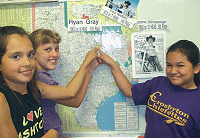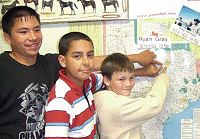This Land Is Their Land
##AUTHORSPLIT##<--->
A Texas elementary school teacher is using a quartet of new computers to educateher students about the region's history and culture—and its passion for rodeo.
UNLIKE WHAT MOST PEOPLE mightassume, Texas school children are not raised oncowboys, cattle, and rodeo. Even rural children aretotally removed from the land, their own local history,and all the things that are considered synonymouswith the state. "The kids don't know wherehamburger comes from," teacher Sandy Harrellsays. "And they didn't know anything about rodeo—and they live in Texas."

WESTWARD HO! Crosbyton students keep track of their favorite rodeo riders’ travels.
Harrell, who has spent 27 years educating kids in her hometown of Crosbyton, TX, 38 miles east of Lubbock, set out last year to rectify this. She had two targets in mind: She wanted to show her fifthgraders at Crosbyton Elementary School what a big wide world was out there waiting for them, while at the same time teaching them about their region's history and culture.
She moved the classroom desks out from the middle of the floor and had her students act out rodeo events like steer wrestling and barrel racing. The kids responded so well that Harrell created an entire lesson plan around the history of the American cowboy.
"There just wasn't anything available about the cowboys and especially about modern rodeo cowboys—so I created it," she says.
What made the lesson such a success was Harrell's skill at incorporating her new wireless computers. Her class had always had to make do with machines passed from the district's high school down through the middle school. At least half of the time the computers didn't work at all, and when they did work, the school's weak internet connection, via old rural phone lines, made moving from one site to the next intolerably slow. And at the small, out-of-the-way elementary school of about 95 students, any kind of storm or simply a strong wind would further impair the performance of the phone lines.
But that all changed when, thanks to federal technology grants, Harrell's class was blessed with four of its own classroom computers, all flat-screen wireless Dells.
"It would be hard to describe how exciting this was for our class," she says. "It has changed every aspect of our day." Harrell reports the new computers have generated a more motivated group of students, longer attention spans to work on projects that are exciting to them, an ability to tackle problems from many different angles, and better reading abilities all the way around.
The new computers generated a more motivated group of students,longer attention spans, an ability to tackle problems from many differentangles, and better reading abilities all the way around.
"Some of the kids had never worked on a computer that really responds. Now we can move from looking up information in the encyclopedias to using the same modern technology that the rest of the world is using."
For at least half the kids in Harrell's class, and possibly more, the school computers are their only link to technology. Most of the kids, 70 percent of whom are minorities, don't have home computers. And of those who do, many don't have internet access.
Harrell says she first took her students on tours of rodeo-related websites. "We visited sites like Prorodeo.com [Professional Rodeo Cowboys Association] and then Pbrnow.com [Professional Bull Riders]." She says that her class also began reading the blogs that some of the cowboys kept.
The students chose which of the riders' blogs they wanted to follow and tracked their schedules—from rodeos in Texas and California to events in Wyoming and New Mexico. The lesson crossed several subjects: Math was involved in adding up the miles the families traveled; geography skills were engaged by finding all the states and towns and marking the route on the wall map; reports about the families and the history of cowboys drew on writing and social studies; and a blocked computer site exercised problem- solving skills.

ALL POINTS HOME Sandy Harrell says new computers helped teach herfifth-graders about the most well-known features of their town and state.
"Many sites, for one reason or another, are blocked," Harrell says. "The kids had to find other ways to find the information. It created a huge learning opportunity about not giving up and finding alternative ways to get the information they needed."
Following the cowboys is much easier now than ever before, due in part to the presence of wireless technology. Professional rodeo riders like Jerome Schneeberger travel with their own laptops that they use to blog about their adventures on the road.
Schneeberger's wife, Haley, a secretary for the Professional Rodeo Cowboys Association, who travels with her husband, goes online to pay her bills and keep in touch with friends and family, as well as to share blogging chores on her husband's website about life on the road. The Schneebergers also maintain a blog on the PRCA's website. That is where the Crosbyton students found them.
"We wrote to them through e-mail," Harrell says. "And they responded, sending e-mails to the kids and autographed pictures, and we'd follow Jerome in the world standings."
The new computers meant that Harrell could gather more kids around her while she taught her lessons and the students looked up information. "The old computers were just so big and bulky there wasn't room for them," she says.
The students were so captivated by the lessons that Harrell made a point of getting in touch with Ryan Gray, a bareback rider who didn't live far from Crosbyton, and got him to visit the school. The kids enjoyed meeting him so much that when Harrell had a substitute for a day, they hustled Gray's phone number off the teacher's desk and called to thank him.
This fall will find Harrell with her very own wireless laptop that she intends to incorporate into outdoor lesson plans and field trips. Crosbyton Elementary School also has an annual project exclusive to fifth-graders: raising money for the local no-kill animal shelter by creating art and selling it via silent auction. Instead of the mess—and the expense—of real paint, Harrell is going to have her kids create their art on Microsoft's Paint program. Their creations will be framed and auctioned off.
"Some go for $2 and some go for $20," Harrell says. "But we've been doing it for about four years now, and the kids really look forward to being in fifth grade so they can do the project. We turned in more than $320 to the shelter last year."
Harrell has big plans for her lessons on the American cowboy as well, including visits from farmers, ranchers, and others. With her skillful use of wireless technology, Crosbyton students will do right by their heritage, learning the history of their own town and state, where their food comes from, and where and how today's American cowboy lives and works.
MaryAnna Clemons is a freelance journalistbased in Colorado Springs, CO.
This article originally appeared in the 10/01/2007 issue of THE Journal.